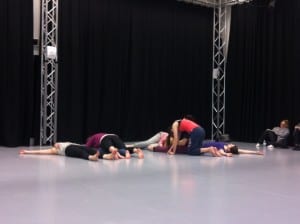Tuesday 11th March 2014
What is your definition of contact improvisation? How do you feel contact improvisation should be described? These were a few questions that began our class. As a group we are influenced by various practitioners of dance with their own theory as to what contact improvisation is. We used those influences today as well as our own experiences to create a group definition. With this definition, which included statements such as ‘A gentle yet active visual art form’ (Utting, 2014), we approached various tasks given to us with a sense of understanding and personal relation.
The previous weeks exercises were compiled in today’s class as we collected everything we have learnt with new techniques of contact. The atmosphere in the dance space was extremely calm and collected which allowed everyone to be free of tension and have a flow with the rhythm of movement. We worked a lot with pressure and pressing into the floor allowing the skin to mould onto different surfaces and skin to skin dancer to dancer connection. We also revisited “flying the limbs” which is where dancers connect through their centre to shift each other’s weight within the space. Today I finally understood that control is a key component in order to keep the centers connected and finding the right balance is essential, once you have found this it is easier to come back to this state of stability.
Our definition also included ‘Bodily connections and communication/conversation.’ (Utting, 2014) as a group we felt that this is key to the definition of contact improvisation as without that communication to another body there wouldn’t be a connection and therefore the exploration of movement would not be as influential as it could be. By this we mean that it is easily done exploring a method of movement on your own however with that connection to someone else it opens up so many more opportunities for experimentation and therefore results in a clearer understanding of those given opportunities.
To complete the understanding of our group definitions we created a score where there was a sense of freedom within the space. The movement seemed to come more frequently without hesitation and the control from each dancer when taking someone weight was continuous. The use of “moments of nothing” created a state of awareness in the room and allowed the relationship between the dancer and audience to build. This relates to how Steve Paxton believes contact improvisation affects its audience ‘It is through the eyes that the audience begins a kinetic response, or a physical empathy with the dancer’ (Turner, 2010, 128).
Works cited:
Utting, Z (2014) Going Up! [seminar] Contact Improvisation: An Ongoing Research Lab DAN2005M, University of Lincoln, 11 March.
Turner, R. (2010) Steve Paxton’s “Interior Techniques”. Contact Improvisation and Political Power, 54 (3) 123-135
